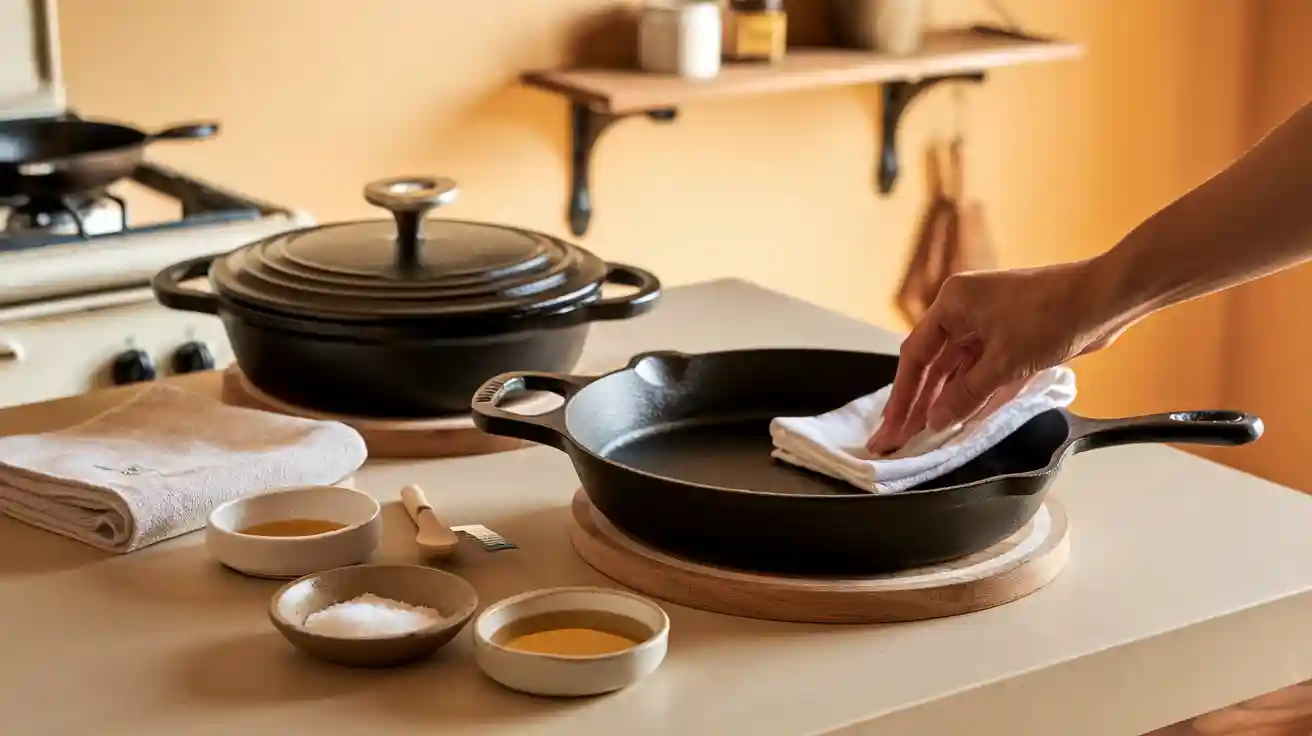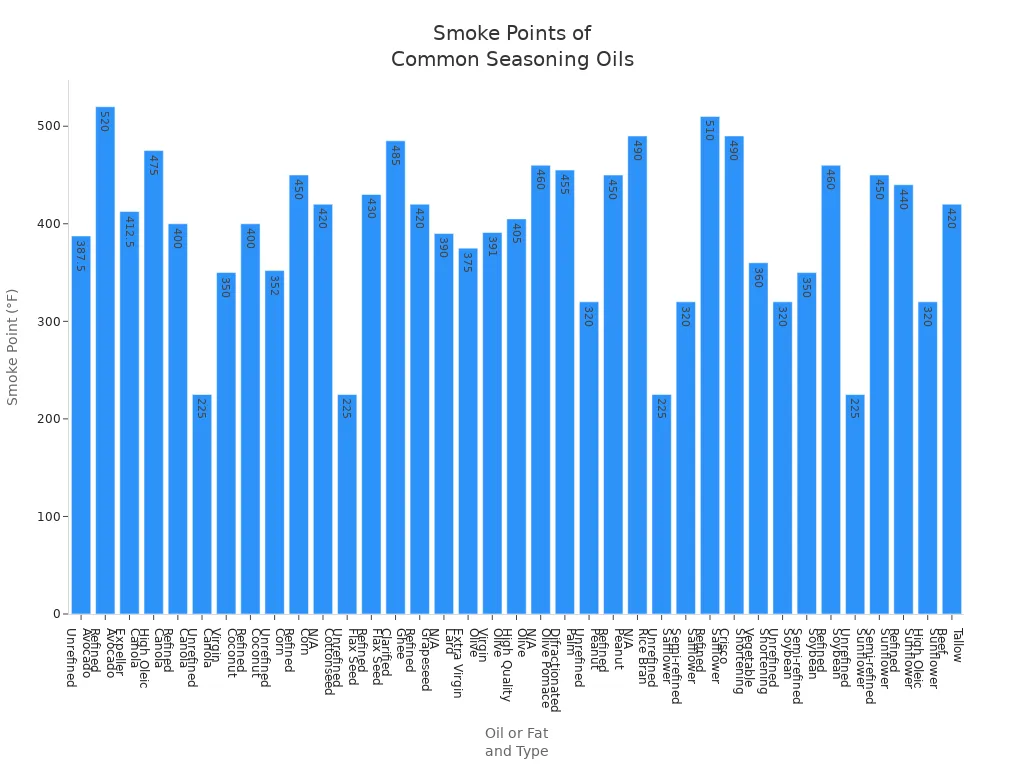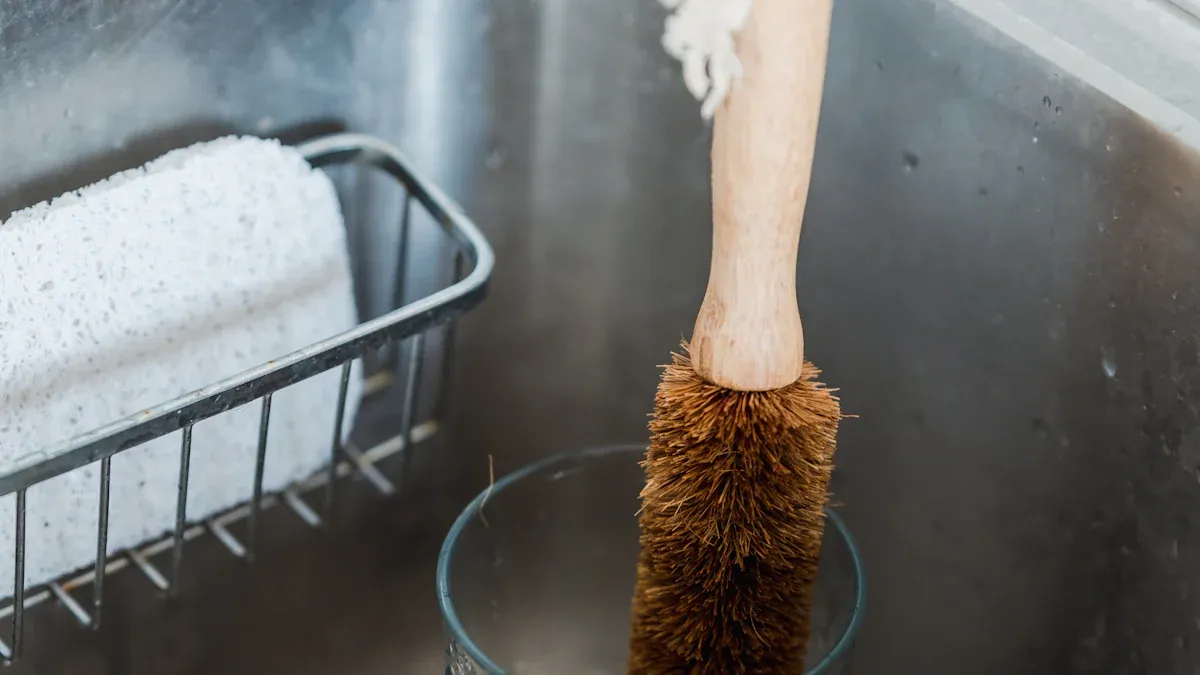
You can make your cast iron cookware set last for generations with proper seasoning and care. Seasoning forms a natural non-stick layer on your cast iron pan, which helps prevent rust and boosts flavor. Clean your cast iron pan gently and apply oil after each use to keep the seasoning strong.
Seasoning Your Cast Iron Cookware Set
What Is Seasoning and Why It Matters
Seasoning is a process that protects your cast iron cookware set and makes it easier to use. When you heat a thin layer of cooking oil on your cast iron pan, a chemical reaction called polymerization happens. The oil bonds with the metal and forms a hard, smooth layer. This layer acts as a natural nonstick surface and keeps moisture away from the iron. You prevent rust and make cooking and cleaning much easier by seasoning your pan. Over time, the seasoning gets better and stronger, giving your cast iron cookware set a shiny, black finish.
Tip: Seasoning does not just help with cooking. It also keeps your cast iron pan looking great and lasting longer.
Choosing the Right Oil for Seasoning
You need to pick the right oil for seasoning your cast iron cookware set. Experts recommend using oils that have a high smoke point and do not add strong flavors. Neutral oils like sunflower, vegetable, peanut, and non-virgin olive oil work well. Flaxseed oil is also a top choice because it creates a hard, durable layer, but it can be expensive. Always use edible oils for safety.
Here is a table showing which oils work best and why:
| Oil Type | Recommendation Status | Reason/Explanation |
|---|---|---|
| Cold-pressed flax/flaxseed oil | Highly recommended | Most efficient for polymerization; sets hardest; recommended by cast iron companies; expensive but effective |
| Neutral frying oils (sunflower, vegetable, peanut, non-virgin/light olive oil) | Recommended | Commonly available; effective for seasoning; practical choice |
| Extra-virgin olive oil | Not recommended | Less effective; considered a waste of money |
| Flavored oils (sesame, hazelnut, walnut) | Not recommended | Leave acrid flavor; do not coat pan well |
| Any oil used must be edible | Essential | Ensures safety and proper seasoning |
The smoke point of the oil matters because you will heat your pan to high temperatures. Refined oils usually have higher smoke points, which makes them safer for seasoning. For example, refined avocado oil has a smoke point of 520°F, while canola oil ranges from 400°F to 475°F. You can see how different oils compare in this chart:

You can use many common oils for seasoning cast iron as long as you keep the oven temperature between 350°F and 500°F.
Step-by-Step Seasoning Process
You can season your cast iron pan at home with a few simple steps. Start by preheating your oven to 350°F. Wash your new pan with a small amount of soap and water, then dry it completely. Next, apply a thin, even layer of cooking oil all over the pan, inside and out. Use a paper towel to wipe away any extra oil so the surface does not look greasy.
Place the pan upside down in the oven. Put a baking sheet or foil on the rack below to catch any drips. Bake the pan for one hour. After baking, turn off the oven and let the pan cool inside. For a stronger seasoning, repeat the oiling and baking process one or two more times. Each round builds up the protective layer and improves the nonstick surface.
Here is a quick list to guide you:
- Preheat oven to 350°F.
- Wash and dry your cast iron pan.
- Rub a thin layer of cooking oil all over the pan.
- Place the pan upside down in the oven with a tray underneath.
- Bake for one hour, then let it cool in the oven.
- Repeat the oiling and baking steps for a stronger seasoning.
Note: Always use thin coats of oil. Thick layers can turn sticky and uneven.
How Often to Season Your Cast Iron Cookware Set
You do not need to season your cast iron cookware set every time you use it. Most experts suggest seasoning it two or three times a year for the best results. If you use your cast iron pan often or notice food sticking, you may need to season it more. If the surface looks dull or rusty, it is time to repeat the seasoning process. Regular cleaning and drying help keep the seasoning strong, so you do not have to do it as often.
Keep your cast iron cookware set in top shape by seasoning when needed and using it often. Cooking with fats and oils helps maintain the nonstick layer.
How to Clean a Cast Iron Pan

Daily Cleaning Routine
You should clean a cast iron pan after every use to keep it in top shape. Start while the pan is still warm. Scrape off food particles with a brush or a polycarbonate scraper. Rinse the pan under hot water and use a soft sponge if needed. Avoid using soap unless absolutely necessary. If you use mild soap, rinse well and dry the pan right away. Never soak your cast iron pan, as this can cause rust.
Follow these steps to clean a cast iron pan daily:
- Scrape off food while the pan is warm.
- Rinse under hot water and use a brush or sponge.
- Dry the pan on the stove over low heat until all water evaporates.
- After cooling, wipe a thin layer of oil on the inside.
- Store the pan dry, and you can place a paper towel inside to absorb moisture.
Tip: Always apply a light coat of oil after you clean a cast iron pan. This step protects the seasoning and prevents rust.
Deep Cleaning for Stubborn Residue
Sometimes, food sticks or residue builds up on your cast iron pan. When this happens, you need a deeper cleaning method. Use hot water and a non-abrasive brush to scrub away food. For tough spots, pour a little water into the pan and simmer it for a few minutes. This loosens stuck bits. You can also use coarse salt as a gentle scrub. Rub the salt around the pan with a paper towel or brush, then rinse and dry.
Deep cleaning does not need to happen often. Only do it when your pan looks dull or has stubborn residue. Always dry the pan completely and reapply oil after deep cleaning to restore the seasoning.
What to Avoid When Cleaning Cast Iron
Some cleaning habits can damage your cast iron pan. Never put your pan in the dishwasher. Do not soak it in water, as this leads to rust and weakens the seasoning. Avoid using steel wool or harsh cleaners, which can strip away the protective layer. Letting your pan air dry can also cause rust. Always dry it right after washing and apply oil before storing.
Note: If you ever scrub off the seasoning or see rust, clean a cast iron pan with salt, dry it, and re-season it right away. Good cleaning and care will keep your pan working well for years.
Maintaining Cast Iron for Long-Term Use
Building Up the Seasoning Layer
You can make your cast iron pan last for years by building up strong layers of seasoning. Each time you apply a thin coat of oil and heat your pan above the oil’s smoke point, the oil bonds to the metal. This process, called polymerization, creates a hard, slick surface that fills the tiny pores in the iron. As you repeat this process, the layers of seasoning get thicker and stronger. A well-developed seasoning layer gives your cast iron pan a smooth, non-stick finish and protects it from rust. Cooking with oils or butter often helps you build up this protective coating. Over time, your pan becomes easier to use and clean.
Tip: The more you use your cast iron pan, the better the seasoning gets. Regular use with the best foods to cook in cast iron, like fried eggs or sautéed vegetables, helps keep the surface in top shape.
Proper Storage Tips
Storing your cast iron pan the right way is key to preventing rust and maintaining the seasoning. Always clean and dry your pan completely after each use. You can heat it on the stove to make sure all moisture is gone. Wipe a light layer of oil on the surface before storing. Store your pan in a cool, dry place, such as a cabinet or oven. If you stack pans, place a paper towel between them to protect the layers of seasoning. Avoid storing food in your cast iron pan, especially acidic dishes, because they can damage the seasoning.
- Store your cast iron pan in a dry spot.
- Use paper towels to absorb moisture.
- Hang your pan or keep it in a well-ventilated area.
Cooking Habits That Help Maintain Seasoning
Your cooking habits play a big role in maintaining cast iron. Use wooden or silicone utensils to avoid scratching the seasoning. Clean your cast iron pan with warm water and a brush while it is still hot. Dry it right away and apply a thin layer of oil. Cooking the best foods to cook in cast iron, such as meats or foods with natural fats, helps reinforce the seasoning. Avoid cooking large amounts of acidic foods, as they can wear down the layers of seasoning. With these habits, your cast iron pan will stay non-stick and rust-free for years.
Troubleshooting Common Cast Iron Cookware Set Issues
Removing Rust from Cast Iron
If you spot a rusty pan, you can restore it with a few simple steps. Start by washing the pan with hot water and dish soap to get rid of dirt and some rust. Next, scrub the surface with coarse salt, like kosher salt, to remove rust without scratching the pan. For heavy rust, soak the pan in distilled white vinegar for up to 12 hours, but do not go over 24 hours to avoid damaging the metal. After soaking, scrub and rinse the pan well. Always reseason the pan after you remove rust from cast iron. Apply a thin layer of oil and heat the pan in the oven or on the stove to rebuild the protective layer.
Tip: After you remove rust from cast iron, dry it right away and store it in a dry place to prevent new rust from forming.
Fixing Sticky or Flaking Seasoning
Sticky or flaking seasoning can make cooking difficult. This problem often happens when you use too much oil, do not heat the pan enough, or use the wrong type of oil. Flaking can also occur if you cook acidic foods in an under-seasoned pan or use metal utensils. To fix this, rub the inside of the pan with salt to remove loose flakes and smooth the surface. Wipe out the salt, then place the pan upside down in a 450°F oven for one hour. Let it cool inside the oven. If the pan is still sticky or flaky, repeat the process. Always use thin layers of oil and bake long enough for proper seasoning.
Note: Proper seasoning builds up over time. Avoid thick coats of oil to prevent stickiness.
Restoring Nonstick Performance
If your cast iron pan loses its nonstick surface, you can restore it. First, clean the pan with coarse salt and water to remove any stuck-on food or rust. Dry the pan completely. Apply a thin coat of oil and bake the pan in the oven to create a new seasoning layer. Store the pan dry, and place a paper towel inside to absorb moisture. Avoid cooking acidic foods often, and do not soak the pan in water. Clean with hot water and a soft brush, dry well, and apply oil before storing. These steps help your pan regain its nonstick performance and keep it in great shape.
You can keep your cast iron cookware set in top shape with regular cleaning and care. Seasoning, proper storage, and gentle cleaning help your pan last for years.
- Cast iron cookware can last for generations when you maintain it well.
- Many users call it reliable and excellent quality.
FAQ
Can you use soap to clean a cast iron pan?
You can use a small amount of mild soap if needed. Rinse well and dry the pan right away to protect the seasoning.
What should you do if food sticks to your cast iron pan?
Scrub the pan with coarse salt and a brush. Rinse with hot water. Dry it completely, then apply a thin layer of oil.
How do you clean a cast iron pan after cooking acidic foods?
Clean a cast iron pan with hot water and a soft brush. Dry it well. Reseason if the surface looks dull or worn.


